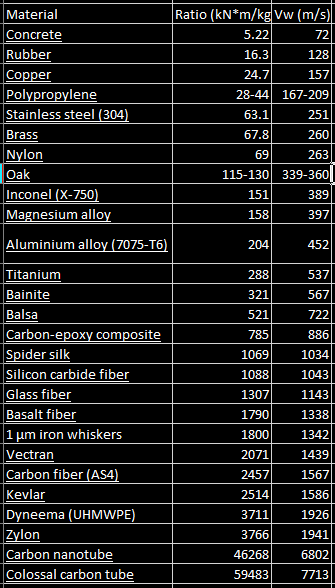So last time I learned that a single stage centrifugal disc pump with edge speed of 2000 m/s could achieve all of my lofty goals. Turns out this is actually really hard to do in real life.
A few years back most of you will remember the Stuxnet virus that hit Iran. It targeted their aluminum centrifuges being used for isotope separation, and caused them to overspeed. When a spinning cylinder (or disc) is spun, the centrifugal force on the material itself causes "hoop stresses" to be set up along the circumference. When this hoop stress exceeds the tensile strength of the material, it separates into several constituent components which travel in a straight line because Newton. They explode.
The math that describes this is actually surprisingly simple (when you let other people do the derivation for you!):
Where Vw is the tangential velocity of the walls (same as the last post), sigma = tensile strength of the material, and rho is the density of the material. Sigma/Rho is also known as specific strength of "strength to weight ratio". Throwing in some numbers I got from Wikipedia, here's a brief list of edge velocities for various materials:
So, it looks like no known material (that can be made into a large disc) can stand up to 2000 m/s rotation. Hence the need to look at multiple stages for this design.
What's neat about this relation is I can simply look at what materials are readily available to me, and design the rest of the pump parameters around that. Vw max directly correlates to the number of pump stages you will need to reach goal total compression ratio (see the last post). Initially, carbon fiber composite looks like it's going to be the best option, I wonder if you can laser cut that? Balsa doesn't look too bad either, but it's strength is probably highly directional with the wood grain, so may not hold up as well in practice. Plus wood does pretty bad in high vacuum (lots of off-gassing). Aluminum is not nearly as good as I thought it would be, but would be easy to machine if someone had a CNC.
By far the best would be individually wrapped carbon fiber strands, with no (or very very little epoxy). That's how lightweight flywheels are made for hybrid cars, with the fibers wrapped circumferentially.

Discussions
Become a Hackaday.io Member
Create an account to leave a comment. Already have an account? Log In.
One thought on the table--it seems like most of the materials on the higher end are quite anisotropic, meaning fabrication method and orientation will be super important if you actually want to achieve the performance listed. For example, I'm guessing that constructing (especially in one's basement) a CFRP structure with a radial fiber pattern would be substantially more difficult than just cutting a disk out of woven sheets.
Are you sure? yes | no
That's a great point, I had noticed that as well. Based on your day job I'm sure you know a lot more about this stuff than I do, thanks for your inputs! The most similar application I found was high speed rotors for energy storage. Those are constructed by wrapping long carbon fibers around a spool, so all the threads are running circumferentially. I can probably dig up the paper again if you are interested. In practice, the rotors were actually breaking due to radial stress, the epoxy binding the fibers together radially gave out long before the fibers themselves could succumb to hoop stress. So to really get the stated "ideal" performance it looks like a careful balance of circumferential fibers AND radial fibers would be needed in just the right weave pattern, with NO epoxy. Weaving carbon fiber is something lots of people have done in their garage, but it is certainly much harder than just buying the premade stuff and sticking it in the laser cutter. If you have a laser cutter (which I don't).
Another consideration though is repeatability. I'd like for the end result to be easily reproduced by others for their own needs. A hand woven fabric might perform well, but one small mistake or defect could be pretty catastrophic. I'd prefer to come up with a design that has more of a safety margin. Next week I hope to start exploding some test discs just to verify the math and see how close it is to real life.
Are you sure? yes | no
awesome, sounds good. I look forward to seeing some exploding test discs.
Are you sure? yes | no